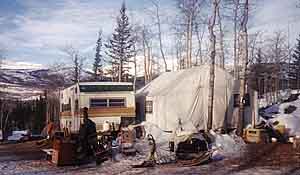
OUR PRECIPITOUS MOVE TO THE YUKON onto a parcel of unimproved bush gave rise to many immediate problems. Water was a necessity. At first we hauled it in buckets from a nearby creek; winter put paid to that. Fortunately we had managed to get a tank buried in the ground; we bought an old-fashioned cast-iron hand pump for the tank. Neighbours with a tank truck who hauled their own water filled our tank for us every three or four weeks, but we learned to be very careful in our use of water. Eventually we bought a small gasoline-powered pump and a pickup truck tank; we still haul all our water that way.

KEEPING WARM WAS AN IMMEDIATE PROBLEM. Our first November
in the Yukon brought sustained temperatures of minus 35 degrees
Celsius. Without a reserve of winter
firewood, we had to use our dog teams to haul stovewood as
we cut it, sometimes on our own parcel, sometimes in a
forest half a mile or so away. Even with a heavily-loaded
sled and Isa riding (a handler was needed to control the
team while I loaded the sled), we found that eight dogs was
too many. Wildlife scent in the bush had the dogs on edge
and our takeoff from a firewood site with a loaded sled was
quite an experience. Six dogs were quite enough!
Somehow we made it through
that first winter, though there were times when we wondered
if we would.
THE FOLLOWING SUMMER saw a high wire fence erected around the
dogyard, as much to keep wildlife out as to keep dogs in. It
had the advantage of allowing us to release them from their
stakeouts for free-run periods, which they enjoyed for half
an hour or so -- then they all wanted to go back on their
stakeout chains.
Late winter brought the death of poor old
GRIZZLY from cancer, so DALLY was bred in March
to SEPALLAMPO. On May 22 1994 she whelped the S-litter, and
our Yukon breeding programme was on its way.
All of our Markovo-Seppalas were registered
with The Canadian Kennel Club over the course of the winter, but
a long wrangle ensued with the Club over our Russian import SHAKAL
IZ SOLOVYEV. By the close of summer there still seemed to be no
end in sight, and we were quite concerned about the possibility
of losing this precious genetic resource while CKC dithered. So
in August NORDE OF SEPP-ALTA was bred to
SHAKAL IZ SOLOVYEV in August for an "insurance litter" while
we continued to correspond and negotiate.

THE Z-LITTER BY SHAKAL EX NORDE was born 4 October 1994. They turned out to be a tremendous confirmation of the Russian stud dog's worth. Eventually CKC refused to register our Russian import or his progeny, thus causing our final break with the national kennel club. We then had to decide what to do. We began correspondence with Agriculture Canada about possible evolving breed recognition for Seppalas. Seppala Network Bulletin was conceived and first published in May of 1995; editing that publication did a lot to help clarify our thinking. Although we had not quite yet fully realised the fact, the seeds had been sown for the Seppala Siberian Sleddog Project. We had always known that Seppalas were really a breed in their own right, that they were not "Siberian Huskies" -- if that was what the show-dogs were. Only as a breed in their own right could they enjoy any real protection from the constant threat of assimilation into the larger mainstream Siberian Husky population.
